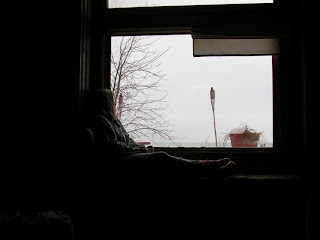
I've been absent from the blog for a spell here as I took a mid-winter outing to a lovely little cabin on Lake Michigan. (More about the trip in the next post...I have to wait at least one more day to officially post next month's "kitchen pilgrimage" after all.) While there, I began reading a delightful new book on my Kindle called, Growing a Farmer: How I Learned to Live off the Land, by Kurt Timmermeister.
The book is such a happy read and so appropriate to the blog that I'm "reviewing" it without even getting a free copy from some publisher. (smile)
The book is refreshing in its camaraderie between the novice farmer and the author. He shares blatantly his early ignorance and failures as he shifted careers from being a successful city (Seattle) baker turned full-scale restaurateur to being a cheese-making dairy farmer on an island off the coast of Washington state. His word pictures make a beautiful balance against a heavy lacing of humor and an across-the-dinner-table literary tone.
One thing we've never discussed in our suburban gardening and canning adventures is the topic of animals. I've considered chickens--not an option according to our neighborhood bylaws; bees--my husband spent a whole year trying to drive them out from building a hive in his basement home office, so another no; and angora bunnies to harvest the wool, fibrefarming it's called--still thinking on that one. Overall, though, the choice to raise livestock does not meet with much support in suburban settings. Still, Timmermeister's seasoned advice on the acquisition of those first farm animals--namely goats--is too funny not to share as a excerpt:
The first animals that people generally acquire are not sheep but goats. In my opinion, this is a poor choice. I hear from many people who think they will move out of the city, quit their jobs, buy a few goats and make goat cheese. I try to react with an enthusiasm that matches theirs. They seem to believe that they are the first to come up with the plan to make goat cheese and leave their jobs in the city...
Goats really are beautiful animals, very clean and tidy and full of personality. Goat cheese is especially tasty and reeks of the French countryside. Little rounds of white cheese, often with some ash or a few flower petals or cracked pepper--it's a lovely pastoral daydream. But the reality of keeping goats is much different. They are beautiful and full of personality, but also can be quite pesky. They have an uncanny ability to outwit any fence, gate or confinement. If they just escaped and wandered around with their sweet demeanor it might work, but their wily intelligence leads them right to the best tree or your favorite plant and they nip it down to the ground. Quickly. Effortlessly. Silently. If you are lucky they will stay on your property and only wreak havoc on your favorite trees. If you aren't so lucky, your neighbor's favorite trees will fall victim to your cute goats as well.
I think they plan it out. Spending their afternoons chewing their cuds and looking over their fence, getting a sense of which plants you really care about. Watching you prune and water and fawn over a beautiful specimen that is close to blooming, something that would break your heart if it were eaten...
 So fun were his descriptions of adventuring into everything farm--from growing orchards and planting veggies as a cash crop to milking his first cow, Dinah, to inadvertently killing his first two seasons' worth of bees before he could even get them into their hives--that I spent almost as much time daydreaming my own broading farm adventures as I did reading about his--the profoundest testament to a book's value that I can make!
So fun were his descriptions of adventuring into everything farm--from growing orchards and planting veggies as a cash crop to milking his first cow, Dinah, to inadvertently killing his first two seasons' worth of bees before he could even get them into their hives--that I spent almost as much time daydreaming my own broading farm adventures as I did reading about his--the profoundest testament to a book's value that I can make!Indeed, his naked admissions of ineptness in the early days of living off the land are far more successful in inviting a reader to take similar initiative than the best written and illustrated how-to book out there...at least to another humble beginner-- like me, for instance!
Hopeful daydreaming!




















